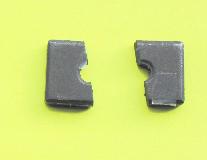(b) If we break one of the flat black magnets as shown, will the pieces want to stay together or fly apart?
You should be able to figure out these without actually breaking a magnet. Of course, you should explain your reasoning, and discuss the implications.

 We have been
describing magnets and how they interact in terms of their poles.
However, there is another way to describe them, in which we draw
arrows on the sides of the magnet instead of poles on the ends
(these arrows have nothing to do with the magnetic field arrows
we were drawing earlier).
We have been
describing magnets and how they interact in terms of their poles.
However, there is another way to describe them, in which we draw
arrows on the sides of the magnet instead of poles on the ends
(these arrows have nothing to do with the magnetic field arrows
we were drawing earlier).
 The arrows run around
the magnet, so that when you view the magnet from one pole end,
they describe a one-way path around the magnet.
The arrows run around
the magnet, so that when you view the magnet from one pole end,
they describe a one-way path around the magnet.
Decorate some of your magnets with arrows like these, and then observe how they account for the interaction of magnets, for the various cases that the magnets are end-to-end or side-by-side: what are the arrows doing when the magnets are attracting, and what are they doing when the magnets are repelling? How could you use the "arrow" description to explain the behavior of the broken magnet shown above?